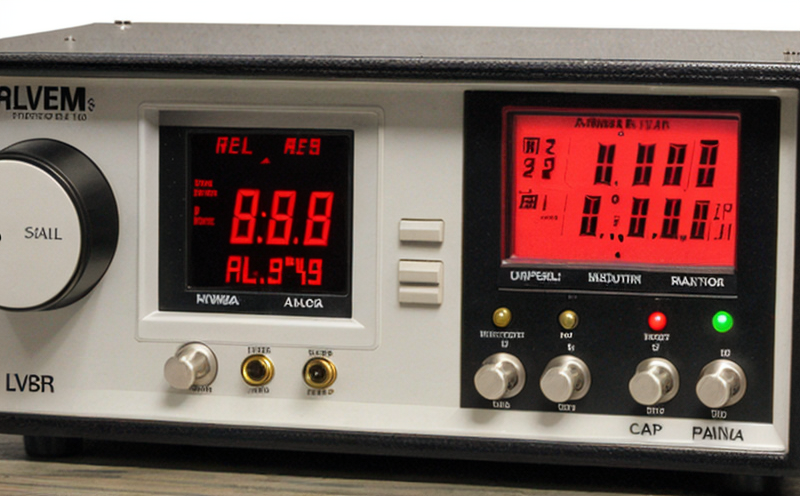ASTM E2625 Calibration of Radiotherapy Beam Dosimetry Instruments
The calibration process outlined in ASTM E2625 is a cornerstone procedure for ensuring precision and consistency in the delivery of radiotherapy beams. This standard provides a robust framework for calibrating dosimetry instruments used in radiation therapy, which are critical for treating various forms of cancer and other diseases.
Accurate calibration ensures that the prescribed dose of radiation reaches the intended target with minimal scatter or error. In the context of Radiation & Nuclear Testing, this is particularly important as even small discrepancies can lead to under-treatment or over-treatment, both of which have significant health implications.
The standard applies primarily to dosimetry instruments used in external beam radiotherapy (EBRT), including but not limited to ionization chambers, film dosimeters, and diode sensors. The calibration process involves the use of reference radiation sources that are traceable to national standards such as those provided by the International Bureau of Weights and Measures (BIPM).
The methodology outlined in ASTM E2625 is designed to ensure that all instruments used in radiotherapy are calibrated to a common standard, thereby reducing variability between different machines and facilities. This is crucial for maintaining consistency across different healthcare providers and ensuring the reliability of dosimetry measurements.
A key aspect of this calibration process involves the use of reference radiation sources such as cobalt-60 or cesium-137 units, which generate photons at specific energies that are well-characterized. The instruments to be calibrated are placed in a setup that mimics the conditions of clinical use, allowing for accurate measurement under realistic scenarios.
The calibration process typically involves the following steps:
- Setting up the reference radiation source and positioning it to deliver the desired beam characteristics.
- Placing the dosimetry instrument in a known position relative to the beam.
- Metering the dose received by the instrument under controlled conditions.
- Comparing this measured value with the expected value based on the reference radiation source's specifications.
- Adjusting or recalibrating the dosimetry instrument as necessary to ensure accuracy within specified tolerances.
The process is iterative, ensuring that each instrument meets the stringent requirements set by ASTM E2625. This standard also provides guidance on how often instruments should be calibrated based on usage and other factors.
Accurate calibration is essential for several reasons:
- To ensure patient safety by delivering the correct dose of radiation.
- To prevent over-treatment, which can lead to unnecessary side effects.
- To avoid under-treatment, which can reduce the effectiveness of the treatment.
- To maintain consistent results across different machines and facilities.
The use of ASTM E2625 ensures that all radiotherapy beam dosimetry instruments meet these critical standards. This not only enhances patient outcomes but also improves overall healthcare efficiency by ensuring that resources are used effectively.
Applied Standards
| Standard Code | Description |
|---|---|
| ASTM E2625 | Standard Practice for Calibration of Radiotherapy Beam Dosimetry Instruments |
| BIPM Traceability | International Bureau of Weights and Measures standards used in calibration. |
The application of ASTM E2625 is essential for ensuring the accuracy and reliability of dosimetry instruments used in radiotherapy. This standard ensures that all instruments are calibrated against a common reference, which is critical for maintaining consistency across different facilities and healthcare providers.
By adhering to this standard, laboratories can ensure that their calibration processes meet the highest international standards, thereby enhancing patient safety and treatment efficacy.
Scope and Methodology
The scope of ASTM E2625 is broad but specific to ensuring accurate dosimetry in radiotherapy. The standard covers the calibration procedures for various types of dosimetry instruments used in external beam radiotherapy, including ionization chambers, film dosimeters, and diode sensors.
The methodology outlined in the standard involves several key steps:
- Setting up the reference radiation source to deliver known doses of radiation.
- Positioning the dosimetry instrument at a specified distance from the beam.
- Metering the dose received by the instrument and comparing it with the expected value.
- Adjusting or recalibrating the instrument as necessary to achieve accuracy within specified tolerances.
This process is designed to be rigorous, ensuring that all instruments meet stringent standards for precision and reliability. The use of reference radiation sources ensures that the calibration process is traceable to national standards, thereby enhancing the credibility and accuracy of dosimetry measurements.
The standard also provides guidance on how often instruments should be calibrated based on usage and other factors, ensuring continuous compliance with international standards.
Industry Applications
- Cancer Treatment: Ensuring accurate dosimetry is critical for effective cancer treatment, especially in radiation therapy.
- Radiation Oncology: Calibration of dosimetry instruments ensures consistent and precise delivery of radiation doses in oncology treatments.
- Medical Research: Accurate calibration supports reliable data collection in medical research studies involving radiotherapy.
| Industry Application | Description |
|---|---|
| Cancer Treatment | Involves accurate dosimetry to ensure effective treatment of cancer patients. |
| Radiation Oncology | Ensures consistent and precise delivery of radiation doses in oncology treatments. |
| Medical Research | Supports reliable data collection in medical research studies involving radiotherapy. |
The application of ASTM E2625 is crucial across these sectors, ensuring that dosimetry instruments are calibrated accurately and consistently. This standard not only enhances the effectiveness of treatments but also improves patient outcomes by minimizing errors and variability in radiation delivery.





